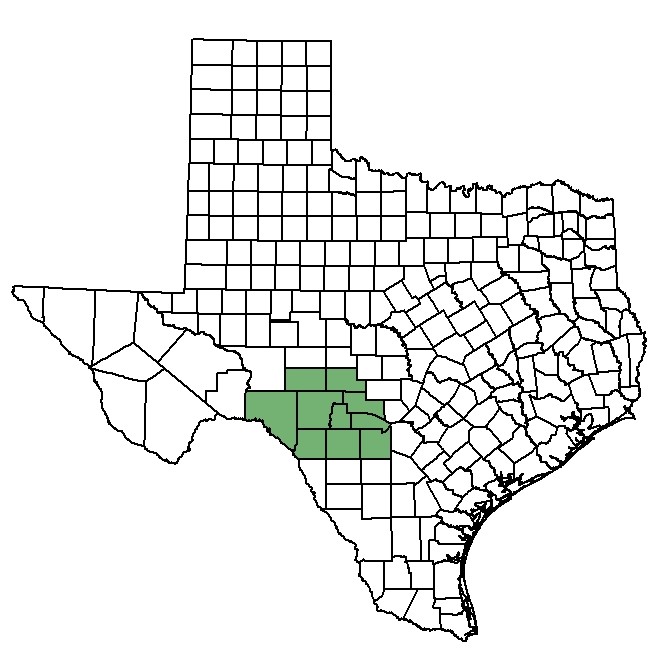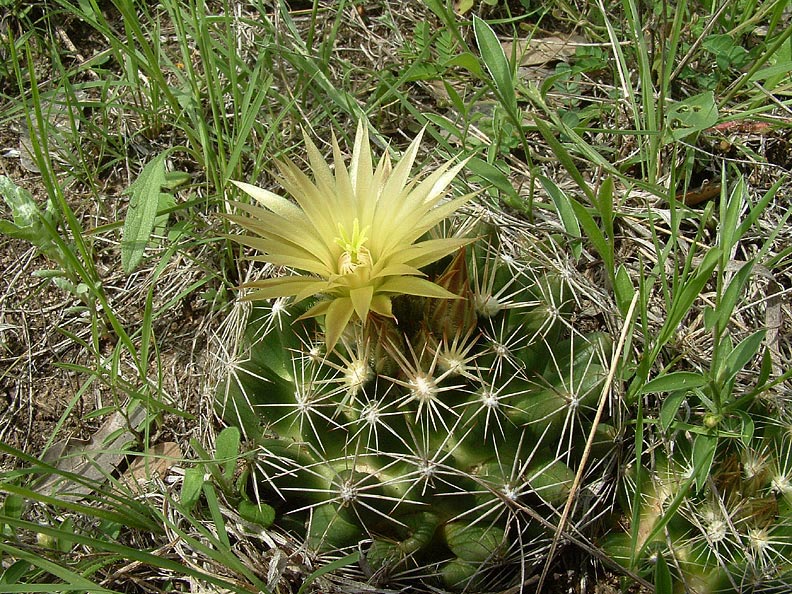Federal and State Listed Species of Texas:
Tobusch fishhook cactus

Current
null
null
Distribution map of Tobusch fishhook cactus (Sclerocactus brevihamatus ssp. tobuschii ).
- Scientific Name
- Sclerocactus brevihamatus ssp. tobuschii
- Other Scientific Names
- Mammillaria tobuschii, Ancistrocactus tobuschii, Ancistrocactus scheeri ssp. tobuschii, Echinocactus tobuschii, Ferocactus tobuschii, Pediocactus brevihamatus ssp.tobuschii
- Other Common Names
- shorthook fishhook cactus
- Status
- Federally Threatened and State Endangered
- Global Rank
- G3T3
- State Rank
- S3
Global Location
Tobusch fishhook cactus is found on western Edwards Plateau of Texas in Bandera, Edwards, Kerr, Kimble, Kinney, Real, Uvalde, and Val Verde counties.
null
Credit:
Description
Tobusch fishhook cactus is a succulent perennial usually with solitary stems that are 3 to 15 cm tall and 1 to 15 cm in diameter. The low dome-shaped stems have 8 to 12, poorly defined, vertical ridges that are divided into spine-tipped, cone-shaped projections. Each projection has spines arising from each tip. Spines turn from yellow to gray as they age, and are covered with microscopic hairs. Most of the spines (radial spines) form a ring around the projection’s tip, and radiate outward and parallel to the stem surface. There are typically 7 to 9, straight, needle-like, irregularly spreading radial spines which grow 1 to 2 cm long. Other spines (central spines) arise interior to the radial spines and point away from the stem. Longer than the radial spines, the three to five central spines are divided into upper and lower spines. The upper two central spines are 2 to 4 cm long and form a “V”; sometimes there are one or two smaller central spines within the “V”. The hooked lower central spine points straight out or at an angle, is stout and 2.2 to 3 cm long. Flowers of Tobusch fishhook cactus are bright yellow, yellowish-green or golden-yellow. The torpedo-shaped fruits are 2.5 to 3 cm long and green with a pink cast when ripe.
Flowers of Tobusch fishhook cactus can be yellowish-green (or golden-yellow or bright yellow - not shown).
Credit: Jackie Poole, Texas Parks & Wildlife Department
Tobusch fishhook cactus has 7 to 9 shorter, needle-like radial spines that arise exterior to 3 to 5 longer central spines. Two upper central spines form a “V”, and a stout lower, hooked central spine points straight out.
Credit: Craig Farquhar, Texas Parks & Wildlife Department
null
Credit:
Similar Species
Short-spined fishhook cactus (Sclerocactus brevihamatus ssp. brevihamatus), although very similar in appearance to Tobusch fishhook cactus, is usually larger, more cylindrical in shape, and has more radial spines (12 to 22). Also, short-spined fishhook cactus is associated with South Texas brushland plant communities and has flowers that are a mixture of muddy pink, green, yellow, and brown. Grooved nipple cactus (Coryphantha sulcata) has straight or curved, but not hooked, spines. The yellow flowers (typically with red centers) open in late March to April, usually well after Tobusch fishhook cactus has flowered.
Short-spined fishhook cactus has more radial spines (12 to 22) than Tobusch fishhook cactus and flowers that are a mixture of muddy pink, green, yellow, and brown.
Credit: Jackie Poole, Texas Parks & Wildlife Department

Grooved nipple cactus has straight or curved spines (but not hooked) and yellow flowers.
Credit: Bill Carr
null
Credit:
null
Credit:
null
Credit:
null
Credit:
Floral Characters
nullLeaf Characters
nullnull
Credit:
null
Credit:
null
Credit:
Habitat
Tobusch fishhook cactus occurs in shallow soils over limestone in grassy or rocky openings in oak-juniper or pinyon pine-oak woodland.
Habitat of Tobusch fishhook cactus.
Credit: Jackie Poole, Texas Parks & Wildlife Department
Life Cycle Events
Flowering occurs from late January to March, and fruiting occurs February to May.
Survey Season
Although a perennial, Tobusch fishhook cactus is most easily identified while in bloom from January to March.
null
Additional Information
- Rare Plants of Texas
- U.S. Fish and Wildlife Service
- NatureServe
- Center for Plant Conservation
- As Ancistrocactus tobuschii in: Powell, A. M. and J. F. Weedin. 2004. Cacti of the Trans-Pecos and adjacent areas. Texas Tech University Press. Lubbock, TX.
- Emmett, R.T. 1995. A study of the reproductive biology of the Tobusch fishhook cactus (Ancistrocactus tobuschii). Section 6 final report. Austin: Texas Parks & Wildlife Department.
- Poole, J.M., S.J. Birnbaum, & W. Calvert. 2003. Annual monitoring of Tobusch fishhook cactus (Ancistrocactus tobuschii) to address the requirement of possible delisting and an assessment of the threat of Gerstaeckeria sp. nov., a cactus weevil. Section 6 final report. Austin: Texas Parks & Wildlife Department.
- Poole, J.M. and G.K. Janssen. 1997. Managing and monitoring rare and endangered plants on highway right-of-ways in Texas. Section 6 final report. Austin: Texas Parks & Wildlife Department.
- Poole, J.M. and G.K. Janssen. 2002. Status update of Tobusch fishhook cactus (Ancistrocactus tobuschii). Section 6 final report. Austin: Texas Parks & Wildlife Department.
- Westlund, B.L. 1991. Cactus trade and collection impact study. Section 6 final report. Austin: Texas Parks & Wildlife Department.
Comments
An undescribed species of cactus weevil (in the genus Gerstaeckeria) has been shown to lay its eggs inside the stem of Tobusch fishhook cactus. The eggs hatch into larvae, which then feed on the inner cactus tissue, thereby killing the plant. The cactus weevil is one of the main causes of death and can wipe out a large population in several years. Longhorn beetles (Moneilema species) also lay eggs inside Tobusch fishhook cactus, which hatch and eventually kill the plant.